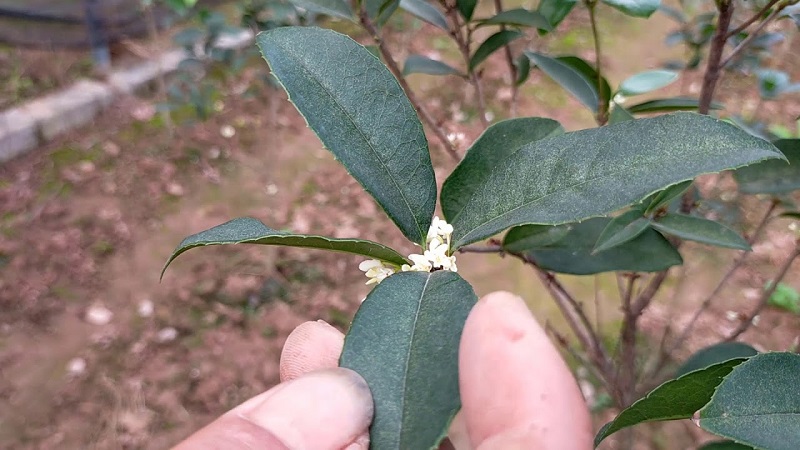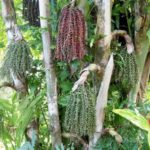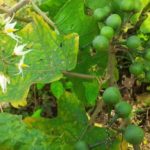The Osmanthus fragrans, or Sweet Osmanthus, is a precious ornamental plant that is widely cultivated and holds significant meaning in life. What is the meaning of the Sweet Osmanthus, and how should it be grown to produce the most beautiful flowers? Let’s find out more in the article below.
1 What is Sweet Osmanthus?
 What is Sweet Osmanthus?
What is Sweet Osmanthus?
Sweet Osmanthus, also known as Cinnamon Flower, has the scientific name Osmanthus fragrans. It belongs to the Asian region, predominantly found in the Himalayan mountain range and some countries such as China and Taiwan. Nowadays, it is widely cultivated in Vietnam.
Sweet Osmanthus holds significant value in both feng shui and traditional medicine, hence it is often sold at high prices, especially for older trees, which can cost up to billions of dong.
2 Characteristics of Sweet Osmanthus. How Many Types Are There?
Characteristics of Sweet Osmanthus
 Flowers of Sweet Osmanthus
Flowers of Sweet Osmanthus
The tree has a small trunk, growing to a height of 3-12 meters, with many branches spreading around. Its leaves are thick, oval-shaped with serrated edges, dark green in color, and have prominent veins.
Sweet Osmanthus bears highly fragrant flowers that bloom throughout the year, especially in autumn, when they are at their most vibrant and release a captivating scent. The flowers grow in clusters and come in various shades of white and light yellow. The tree produces very few fruits, which are small, green, and contain seeds, usually blooming in the spring.
How Many Types of Sweet Osmanthus Are There?
 Vietnamese Sweet Osmanthus
Vietnamese Sweet Osmanthus
As Sweet Osmanthus is a valuable tree with a high price in Vietnam, the market has introduced Chinese Sweet Osmanthus, also known as “Moc Huong Tau,” to provide a more affordable option for those who wish to own this tree. There is a significant price difference between the two types, and it can be challenging to distinguish between them. We will share some tips to help you identify the origin:
Vietnamese Sweet Osmanthus
The leaves of the Vietnamese variety are thicker, with serrated edges, prominent veins that are visible to the naked eye, and evenly distributed, lush flowers. The trunk has many cracks and dark spots, showing signs of roughness.
Chinese Sweet Osmanthus
The leaves of this variety are thinner, larger, and rounder, with smooth edges and less prominent veins. The flowers are unevenly distributed and less abundant. The trunk is smooth and shiny, with fewer cracks and dark spots.
3 Meaning of Sweet Osmanthus. Which Birth Signs Does It Suit?
Meaning of Sweet Osmanthus
 What is the meaning of Sweet Osmanthus?
What is the meaning of Sweet Osmanthus?
The Sweet Osmanthus may not have the flashy appearance of other ornamental plants, but its captivating fragrance adds a unique, humble beauty to this unassuming species. The soft colors of its flowers, combined with their intense fragrance, have inspired the Vietnamese saying, “Sắc trà hương mộc” (Tea’s color, Sweet Osmanthus’ scent), reflecting the culture of hard-working and modest Vietnamese people.
Which Birth Signs and Elements Does Sweet Osmanthus Suit?
Growing Sweet Osmanthus in your home is believed to attract luck and wealth for homeowners of all five elements in the Oriental philosophy. However, the yellow and white flowers of the Sweet Osmanthus are particularly suitable for the Metal element.
Sweet Osmanthus is believed to bring good fortune to people born in the following years of the Metal element: Nhâm Thân (1932, 1992), Quý Dậu (1933, 1993), Canh Thìn (1940, 2000), Tân Tỵ (1941, 2001), Giáp Ngọ (1954, 2014), Ất Mùi (1955, 2015), Nhâm Dần (1962), Quý Mão (1963), Canh Tuất (1970), Tân Hợi (1971), Giáp Tý (1984), Ất Sửu (1985).
4 Benefits of Sweet Osmanthus
 Sweet Osmanthus Bonsai
Sweet Osmanthus Bonsai
Indoor Ornamental Plant
Sweet Osmanthus is easy to grow and effective in purifying the air, making it a popular choice for indoor plants of various sizes. It adds beauty and fragrance to any home.
Its pliable branches and long lifespan make it ideal for bonsai art, creating aesthetically pleasing shapes while providing a hobby for many enthusiasts of this art form.
Herbal Tea
 Using Sweet Osmanthus flowers to make herbal tea
Using Sweet Osmanthus flowers to make herbal tea
Sweet Osmanthus flowers have a delicate fragrance and have been used to make tea for centuries. The flowers are infused with tea leaves in teapots to create a delightful beverage. Sweet Osmanthus tea also has blood circulation and blood pressure regulation benefits similar to green tea.
Medicinal Uses
In traditional medicine, Sweet Osmanthus is considered a precious herb. Its various parts can be used to create remedies for different ailments. The flowers, with their pungent and hot properties, are used to treat abdominal pain, while the roots are effective against bone and joint pain, rheumatism, and arthritis. The fruits of the tree are used to treat liver and stomach ailments.
Cosmetics and Skincare
Sweet Osmanthus flowers are used to create natural beauty and skincare products, such as shampoos, conditioners, and perfumes, helping women achieve a radiant appearance and a subtle, pleasant fragrance.
5 How to Grow and Care for Sweet Osmanthus for Beautiful Flowers
How to Grow Sweet Osmanthus
Sweet Osmanthus is easy to grow and not picky about soil type. It can be propagated through seed germination or cutting, with the latter being more popular as it shortens the growing time. If you choose to grow from seeds, ensure you source high-quality seeds for healthy plant growth.
First, select healthy branches free from pests and diseases. While Sweet Osmanthus is adaptable to different soils, it is best to choose soil with a thick layer of organic matter that is loose, well-drained, and rich in nutrients. You can enhance the soil by mixing it with compost, coconut coir, or rice husks.
Next, dig a hole about 15-20 cm deep in a shaded area and place the cutting in it, securing it firmly and compacting the soil around it. Water the plant regularly to ensure its growth. After about a month, when the young plant has developed roots, you can transplant it to a pot or your desired location.
 How to grow and care for Sweet Osmanthus
How to grow and care for Sweet Osmanthus
How to Care for Sweet Osmanthus for Beautiful Flowers
Watering: Sweet Osmanthus loves water, so ensure you water it regularly, preferably twice a day, in the early morning and late afternoon, for optimal growth. However, avoid overwatering, as it can lead to waterlogging.
Light: Place the plant in an area with natural light but avoid direct sunlight, as it can cause the plant to dry out and lose water. The ideal temperature range for its growth is between 18 and 25 degrees Celsius.
Fertilizer: To promote healthy growth and frequent flowering, fertilize the plant annually or as needed. Use fertilizers containing NPK (nitrogen, phosphorus, and potassium) to provide essential nutrients.
Pest Control: Sweet Osmanthus is susceptible to insect infestations, so keep an eye out for pests and apply appropriate insecticides when necessary. However, avoid overusing pesticides, as they can affect the flower’s fragrance. Regularly prune dry or withered branches to encourage lush growth.
6 Where to Buy Sweet Osmanthus and Price Range
 Price and purchase locations for Sweet Osmanthus
Price and purchase locations for Sweet Osmanthus
Where to Buy Sweet Osmanthus?
When choosing a place to buy Sweet Osmanthus, it is essential to research the seller’s reputation and the tree’s variety. You can purchase Sweet Osmanthus from online or physical stores. Here are some suggestions:
In Da Nang
Hoa cảnh Quang Vỹ: 2A Đinh Thị Vân, P An Khê, Thanh Khê, Da Nang
In Hanoi
Công ty TNHH MTV Cây cảnh Hà Nội: 628 Hoàng Hoa Thám, Tây Hồ, Hanoi
Thế giới cây và hoa: 89 Bùi Huy Bích, Hoàng Liệt, Hoàng Mai, Hanoi
In Ho Chi Minh City
Cây Xinh: 74/1 Street 19, Ward 8, Go Vap District, Ho Chi Minh City
Vườn ươm Trưng bày cây nhỏ: 433/9 Bình Thành, Ward 2, Binh Hung Hoa B, Binh Tan District, Ho Chi Minh City
Price of Sweet Osmanthus
Sweet Osmanthus is a precious tree with numerous benefits, and its price reflects that. Young tree seedlings can cost a few hundred thousand dong, while larger, older trees can range from a few million to hundreds of millions of dong. For ancient Sweet Osmanthus trees, the price can even reach billions of dong.
The information provided above covers the meaning, cultivation, and benefits of Sweet Osmanthus. We hope that growing this meaningful tree brings you much luck and joy.
Did you know?






































